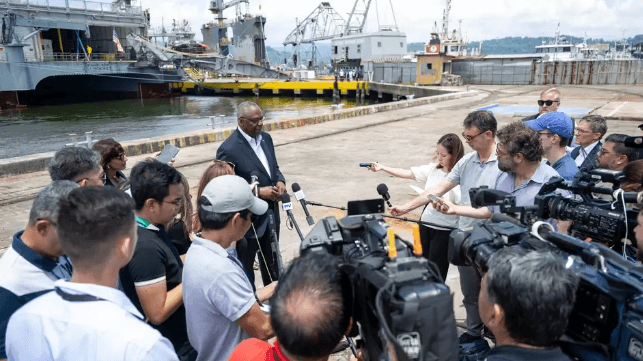Putin's Arctic Naval Expansion: Analyzing The Renewed Activity

Table of Contents
Military Infrastructure Development in the Russian Arctic
Putin's Arctic strategy hinges on strengthening its military capabilities in the region. This involves significant investment in new and upgraded naval bases, alongside the deployment of advanced weaponry. This robust military infrastructure solidifies Russia's claim to the Arctic's resources and its influence over crucial shipping lanes.
New and Upgraded Naval Bases
Russia is modernizing and expanding its existing Arctic naval bases and constructing new ones. Key locations include Murmansk, Severomorsk, and Tiksi, all strategically positioned to project power across the Arctic Ocean. These upgrades bolster Russia’s Arctic naval base capabilities, preparing them for prolonged operations in harsh conditions.
- Murmansk: Significant expansion of docking facilities to accommodate larger nuclear submarines and icebreakers.
- Severomorsk: Modernization of repair and maintenance facilities, improving the readiness of the Northern Fleet.
- Tiksi: Development of new infrastructure, including fuel storage and improved supply lines, extending Russia's reach further east in the Arctic.
- Improved capabilities for supporting nuclear submarines: Enhanced maintenance and logistical support for Russia's nuclear submarine fleet, crucial for power projection and strategic deterrence.
Deployment of Advanced Weapon Systems
The Russian Arctic military is equipped with cutting-edge weaponry, further enhancing its capabilities. This includes nuclear-capable submarines and modernized surface vessels, designed to operate effectively in the challenging Arctic environment. The deployment of these advanced weapons systems significantly alters the regional security dynamic.
- Nuclear-capable submarines: These submarines provide a significant deterrent and project power across vast distances.
- Modernized surface vessels: Icebreakers and patrol vessels equipped with advanced sensors and weaponry are crucial for surveillance and control.
- Coastal defense systems: Improved coastal defenses protect Russian interests and infrastructure from potential threats.
- Potential impact on neighboring countries and international relations: The deployment of advanced weapons systems raises concerns among neighboring countries and has the potential to escalate tensions.
Increased Naval Activity and Exercises
The frequency and scale of Russian naval exercises in the Arctic have dramatically increased in recent years. These exercises demonstrate Russia's commitment to its Arctic strategy and serve as a clear message to other nations operating in the region. This heightened naval activity highlights Russia’s assertive posture within the Arctic.
Frequency and Scale of Naval Exercises
Russia conducts regular large-scale naval exercises involving multiple vessels, submarines, and air assets. These exercises simulate various scenarios, including defense against attacks and the projection of power. The strategic objectives are to test readiness, improve interoperability, and demonstrate Russia's commitment to its Arctic presence.
- Zapad exercises: Large-scale military exercises involving land, sea, and air forces, showcasing Russia's comprehensive military capabilities in the Arctic.
- Northern Fleet exercises: Regular drills by the Northern Fleet, honing the skills and capabilities of its personnel and equipment.
- Strategic message conveyed: These exercises communicate Russia's determination to maintain its dominance in the Arctic region.
Enhanced Surveillance and Patrol Capabilities
Russia has significantly enhanced its surveillance and patrol capabilities in the Arctic. This includes utilizing advanced icebreakers, patrol vessels, and air assets to monitor the region, secure its resources, and project its influence. These advancements significantly enhance Russia's ability to control and monitor the Arctic environment.
- Nuclear-powered icebreakers: These vessels enhance Russia's ability to navigate and operate in the Arctic ice, opening new areas for exploration and resource extraction.
- Advanced surveillance technology: Modern sensors and communication systems provide comprehensive monitoring of the Arctic's maritime domain.
- Air assets: Increased deployment of long-range patrol aircraft and helicopters expands Russia's surveillance and response capabilities.
- Implications for maritime security and resource control: Enhanced surveillance allows Russia to better protect its interests and resources in the region.
Geopolitical Implications and International Response
Putin's Arctic naval expansion has significant geopolitical implications, primarily posing a challenge to Western influence in the region and sparking international responses. The competition for resources and control of Arctic shipping routes is intensifying, leading to a complex and evolving situation.
Challenge to Western Influence
Russia's strengthened military posture in the Arctic directly challenges the influence of NATO and other Western powers. The competition for control over resources and strategic shipping routes is intensifying, leading to increased geopolitical tensions.
- Impact on NATO: Russia's actions necessitate a strategic response from NATO, including enhanced military presence and joint exercises in the region.
- Strategic competition for resources: The Arctic's vast reserves of oil, gas, and minerals are attracting significant international interest, increasing the competition between nations.
- Control of shipping routes: The Arctic's melting ice cap is opening new shipping routes, potentially altering global trade patterns and increasing the strategic importance of the region.
International Reactions and Countermeasures
The international community, particularly NATO and the United States, has responded to Russia's actions with a combination of military exercises, diplomatic initiatives, and sanctions. These responses aim to deter further Russian aggression and maintain regional stability.
- Increased military presence: NATO and the US have increased their military presence in the Arctic, conducting joint exercises and deploying forces to the region.
- Diplomatic initiatives: Several countries have engaged in diplomatic efforts to de-escalate tensions and promote cooperation in the Arctic.
- Sanctions: Some countries have imposed sanctions on Russia in response to its actions in the Arctic and elsewhere.
- Effectiveness of responses: The effectiveness of these countermeasures is an ongoing debate, with ongoing assessments of their impact on Russian actions.
Conclusion: Putin's Arctic Naval Expansion: A Call for Continued Analysis
Putin's Arctic naval expansion represents a significant shift in the geopolitical landscape of the Arctic. The expansion of military infrastructure, increased naval activity, and deployment of advanced weapons systems have all contributed to Russia's growing dominance in the region. The international response, while significant, necessitates continued monitoring and analysis to understand the long-term impacts on regional stability and global security. Understanding Putin’s Arctic naval expansion is critical for assessing future regional stability. Continue to follow developments in Russia's Arctic military buildup and its implications for the global balance of power. The strategic competition for Arctic resources and control of vital shipping lanes demands continuous scrutiny and informed discussion. Further research into Putin's Arctic naval expansion is crucial for informed decision-making by governments and international organizations.

Featured Posts
-
 Ny Traenare Foer Atalanta De Senaste Uppgifterna
May 13, 2025
Ny Traenare Foer Atalanta De Senaste Uppgifterna
May 13, 2025 -
 Myanmar Prioritas Penindakan Tegas Judi Online Dan Penipuan Telekomunikasi
May 13, 2025
Myanmar Prioritas Penindakan Tegas Judi Online Dan Penipuan Telekomunikasi
May 13, 2025 -
 Atalanta Vs Lecce Fecha 34 Serie A En Vivo Y En Directo Por Tn
May 13, 2025
Atalanta Vs Lecce Fecha 34 Serie A En Vivo Y En Directo Por Tn
May 13, 2025 -
 Skarlett Yokhansson Arestovan Stalker Planirovavshiy Terakt
May 13, 2025
Skarlett Yokhansson Arestovan Stalker Planirovavshiy Terakt
May 13, 2025 -
 Bar Roma Toronto A Blog To Guide
May 13, 2025
Bar Roma Toronto A Blog To Guide
May 13, 2025
